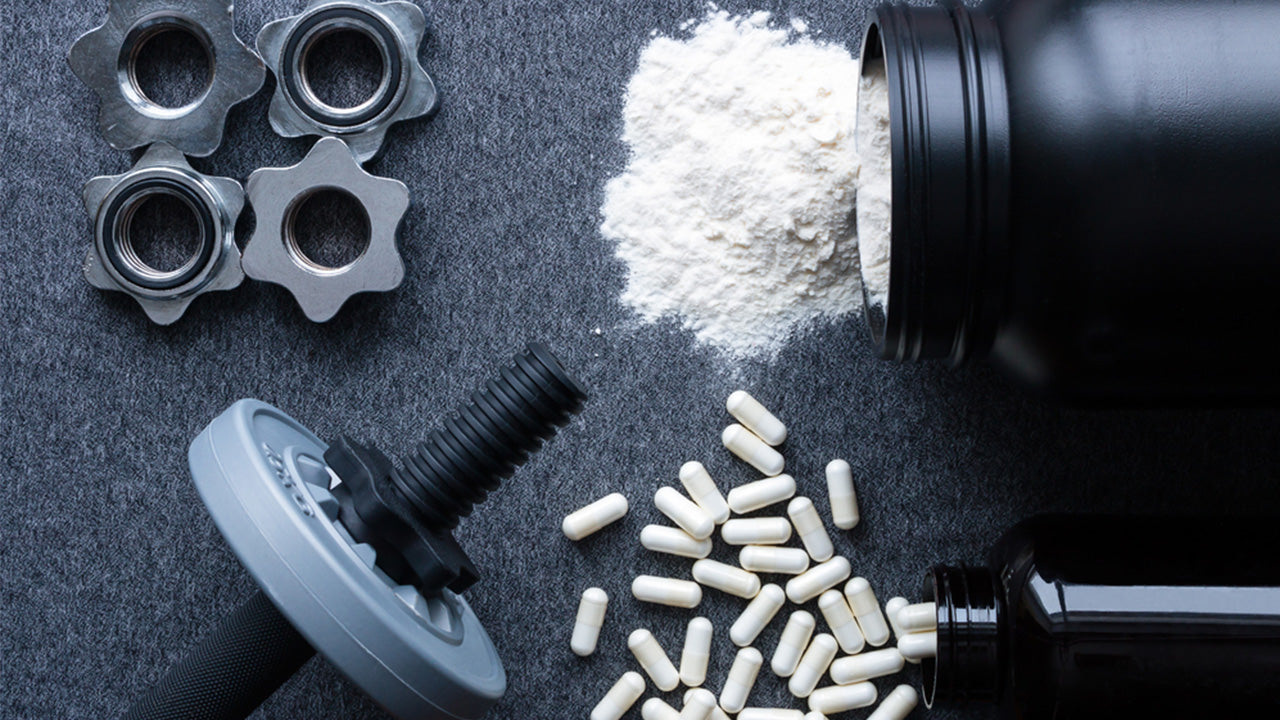EAA Supplements: The Best Amino Acids for Muscle Growth
 By: by Amino Science
By: by Amino Science

Before we get into the best amino acids for muscle growth, let’s first review the makeup of muscle. Muscle tissue is composed of a variety of proteins that are in a constant state of turnover—proteins that are no longer functioning well are being broken down and new ones are being produced. Muscle growth occurs when the rate of synthesis of new muscle protein exceeds the rate of breakdown.
Muscle protein is composed of 20 different amino acids hooked together in a specific order. Nine of the amino acids are essential amino acids (EAAs) and cannot be produced in the body. The other 11 are nonessential (NEAAs) and can be produced in adequate amounts within the body.
Muscle protein synthesis (the building of new muscle protein) involves a series of molecular events that result in the component amino acids being linked together in a specific order. For this reason, amino acids are often called the building blocks of protein. Making a complete protein, therefore, requires adequate availability of each of the amino acids. In that sense, there is no individual best amino acids for muscle growth, because they are all required to produce muscle protein. Rather, there are formulations of amino acids that are “best” for specific circumstances, such as building muscle.
Where Do Amino Acids Come from for Muscle Protein Synthesis?
When protein is broken down during muscle protein turnover, amino acids are released into muscle cells. Most of these amino acids become the precursors for the synthesis of new muscle protein. However, some of the amino acids from protein breakdown are released into the blood and delivered to other tissues and organs, and still other amino acids from protein breakdown are irreversibly oxidized/damaged. Therefore, the rate of reincorporation of amino acids from protein breakdown into newly synthesized muscle protein will always be less than the rate of protein breakdown. Without other sources of amino acids, a reduction of muscle protein and subsequent muscle loss occurs.
There are two ways to get the additional amino acids you need for muscle protein synthesis.
- They are produced in the body. (NEAAs can be produced in the body, so only a minimal amount must be consumed in the diet to meet all demands.)
- EAAs, on the other hand, cannot be produced in the body and must be consumed in the diet.
Research shows that consuming EAAs stimulates muscle protein synthesis and helps build muscle, but eating more NEAAs doesn’t add any further stimulus. When EAAs are consumed, the additional NEAAs required for the production of complete proteins are produced in the body. Ingesting EAAs, either as dietary protein or as amino acid supplements, shifts the balance between synthesis and breakdown of muscle protein to favor the net production of new muscle protein, which defines muscle gain.
What Are the Best Amino Acids for Muscle Growth?
Muscle protein is composed of a specific amount of each amino acid, hooked together in a specific order. In that sense, all the amino acids are equally important, as a shortage of any of them will stop the process of synthesis.
The EAA in shortest supply is called the limiting EAA. The availability of the limiting EAA will limit the rate of muscle protein synthesis, regardless of the availability of all the other EAAs and NEAAs. Therefore, you could say that the limiting amino acid in any formulation of EAAs is the most important.
This is the major problem with supplements that only have the branched-chain amino acids (BCAAs) leucine, isoleucine, and valine. Since the other essential amino acids are not provided, the rate of muscle protein synthesis is not improved. Because of this, BCAA supplements have been proven to provide a far smaller effect on muscle growth than a complete EAA formulation.
It is possible to gain insight into the amount of each EAA that is needed to avoid that EAA being the limiting EAA by looking at the requirements for the individual EAAs. By definition, NEAAs are not required in the diet, so when we talk about dietary requirements we are talking only about EAA requirements. The dietary requirement for each EAA differs. Here are the daily requirements for EAAs for adults as published by the Food and Agriculture Organization of the World Health Organization (FAO/WHO).

The requirements are based on a number of factors, including the composition of total body protein. From the requirements shown above, it is clear that all EAAs are not “equal.” The requirements for leucine and lysine are the highest, while the requirement for tryptophan is quite low.
It could be argued that the best amino acids for muscle building parallel the individual requirements of the EAAs. Indeed, that is the basis for the official FAO/WHO grading of protein quality, called the Digestible Indispensable Amino Acid Score (DIAAS). Indeed, an EAA supplement that closely parallels this distribution will be an effective stimulant of muscle protein synthesis in any circumstance. The bottom line is that you need all the essential amino acids to have any effect on muscle mass, and any nonessential amino acid need not be included in a dietary supplement.
Leucine for Muscle Growth
There has been considerable research over the past 15 years that indicates that alternative mixtures of EAAs may be more beneficial in particular circumstances. Most of the research has centered on the EAA leucine. In addition to being the most abundant EAA in body protein, under certain circumstances, leucine can function to regulate molecular processes within the muscle cell. In those circumstances, it can be called a “nutraceutical.”
Leucine can activate the molecule called mTOR, which gets muscle protein synthesis started. Various conditions associated with progressive muscle breakdown and loss of muscle strength, such as cancer, heart failure, and aging, can suppress the activity of mTOR and associated molecules. When mTOR activity is limited, it may be preferable to increase the proportion of leucine to as high as 35% to activate mTOR. At the same time, activation of mTOR and associated molecules in the muscle cell is not sufficient to increase muscle protein synthesis. You also need an abundance of all EAAs to produce complete proteins. Therefore it is necessary to limit the proportion of leucine in an effective dietary supplement to below 40% so that sufficient amounts of the other EAAs can be included.
If extra leucine is added to a dietary supplement such as whey protein powder to capitalize on its action as a nutraceutical, then the remainder of the supplement should provide the other EAAs in proportion to their contribution to the composition of muscle protein. It seems logical that this would be dictated entirely by the composition of muscle protein, but it is not quite so straightforward.
The absorbed ratios of the different EAAs will not be directly reflected in the EAAs inside the muscle cells because some amino acids are transported into the cell faster than others. Lysine, in particular, is transported sluggishly into the muscle. When lysine is consumed, less lysine will enter the muscle cell than would be expected from the profile of the consumed EAAs. Consequently, to increase the lysine concentration inside the muscle cell in proportion to the lysine content of muscle protein it is necessary that lysine comprise 20% or more of the total EAAs consumed to achieve the maximal muscle-building effect.
Different Strokes for Different Folks
The most effective EAA supplement for muscle growth will have all the EAAs and roughly parallel the requirements cited above. However, alternative formulations may be “best” in different situations. For example, while a high proportion of leucine may be best for older individuals with heart failure, a disproportionate amount of leucine may not be needed by a young athlete after a resistance workout. This is because the resistance workout will activate mTOR and associated molecules, and if the proportion of leucine is in line with the composition of muscle protein (around 23%), then relatively more of all the other EAAs needed to produce complete protein can be included in the supplement.
Even the optimal formulation for exercise might vary, depending on when the supplement is consumed and the type of exercise. For example, endurance training causes a selective increase in leucine oxidation, in which case a supplement high in leucine would be optimal as a post-workout supplement following exercise to speed up muscle recovery.
If the EAA supplement is meant to be consumed as a pre-workout supplement for exercise performance, it may be formulated to optimize the concentrations of neurotransmitter precursor availability in addition to providing EAAs for muscle protein synthesis.
Regardless of the specific circumstance it is meant for, the best formulation will include all the EAAs and not just the BCAAs or specific amino acids like beta-alanine or arginine. A complete formulation will more effectively stimulate the production of new muscle protein than any individual or sub-group of EAAs possibly can.
Look no further than Amino Co supplements, complete essential amino acid blends expertly formulated in the ideal ratios for athletic performance, active aging, and recovery from illness, exercise, injury, and surgery. Shop our product line.

Up to 25% off Amino
Shop NowTAGS: supplements
Join the Community
Comments (0)
Most Craveable Recipes




 833-264-6620
833-264-6620



















